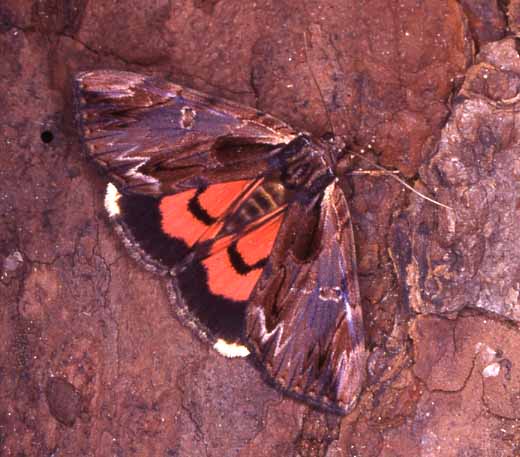Catocala ultronia
Catocala ultronia
kah-TOCK-uh-lahmmul-TROH-nee-uh
(Hubner, 1823)
Eunetis ultronia

Catocala ultronia, courtesy of James Adams.
This site has been created by
Bill Oehlke at oehlkew@islandtelecom.com
Comments, suggestions and/or additional information are welcomed by Bill.
| TAXONOMY:
Superfamily: Noctuoidea
Family: Noctuidae
Group: Noctuinina
Subfamily: Catocalinae
Genus: Catocala, Schrank, 1802
species: 8857 ultronia
| |
MIDI MUSIC
"Moon River"
copyright C. Odenkirk
MIDI CITYON.OFF
<bgsound src="moon.mid" LOOP=FOREVER>
|
DISTRIBUTION:

Catocala ultroni form celia, bait, Mason, Ingham County, Michigan,
July 7, 1994. courtesy of Harry King.

Catocala ultroni form celia (verso), bait, Mason, Ingham County, Michigan,
July 7, 1994. courtesy of Harry King.
Occasionally the lower wings will be yellow instead of orange.
There is considerable variation in forewing pattern as shown in this
specimen from Ontario, courtesy of Lynn Scott, the specimen from
Marion County, Florida, courtesy of Leroy Simon and in the three
specimens courtesy of Vernon A. Brou at botom.

Catocala ultronia courtesy of Lynn Scott

Catocala ultronia courtesy of Leroy Simon
The forewings are typically gray-brown, with a dark lower margin and
a characteristic brown patch near the wingtip.
The hind tarsi have three rows of spines. The outer wing margin
(lower wings) is heavily barred with a pure white patch at the apex.

Catocala ultronia, Peterborough, Ontario, July 22, courtesy of
Tim Dyson.

Catocala ultronia undersides, Peterborough, Ontario,
July 27, 2006 courtesy of
Tim Dyson.
Visit Catocala ultronia, June 30, 2008, Montgomery County, Tennessee, in Tom Payne Tennessee Catocala Collection.
FLIGHT TIMES AND PREFERRED FOOD PLANTS:
ECLOSION:Adults eclose from pupae amongst
ground litter or near the soil surface.Usually when adults alight
on a vertical surface, they align themselves with bodies vertical (ultronia rest with head down).
I wonder if this specimen is trying to take advantage of the
horizontal grey mortar line. Image courtesy of Lynn Scott.
|  |
SCENTING AND MATING:
Catocala ultronia females
emit an airbourne pheromone and males use their antennae to track the
scent plume.
EGGS, CATERPILLARS, COCOONS, AND PUPAE:
Grey, cushion shaped, sculptured eggs are deposited on tree bark in the fall and
hatch the following spring.
Note the prominent horn on the fifth abdominal segment.
There is a distinct black line on top of head and an oblique black
line running (anterior) from base of the slightly enlarged dorsal
scoli of eight abdominal segment. Dense and relatively long fringe
and body are grey. Image courtesy of David Wagner. |
 |
Larval Food Plants
Listed below are primary food plant(s) and alternate food plants.
It is hoped that this alphabetical listing followed by the common
name of the foodplant will prove useful. The list is not exhaustive,
although some species seem very host specific.
Experimenting with closely related foodplants is worthwhile.
Fraxinus pennsylvanica.....
Malus
Populus grandidenta
Prunus pensylvanica
Prunus serotina
Prunus virginiana
Tilia americana
|
Green ash
Apple
Big Tooth Aspen
Pin cherry
Wild black cherry
Choke cherry
American basswood, American linden
|



This page is brought to you by
Bill Oehlke and the
WLSS. Pages are on space rented from Bizland. If you would like
to become a "Patron of the Sphingidae or Catocala
Sites", contact Bill.
Please send sightings/images to Bill. I will do my best to respond to
requests for identification help.
Use your browser "Back" button to re4turn to the previous page.
Enjoy one of nature's wonderments: Live
Saturniidae (Giant Silkmoth) cocoons.

Click on the flashing butterfly to show
appreciation for this site
and to visit other insect related
sites. |

|
Return to Canadian Index
Return to Main Index















